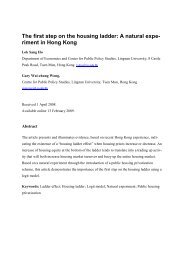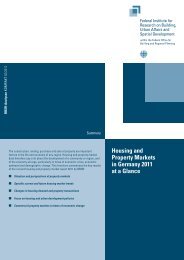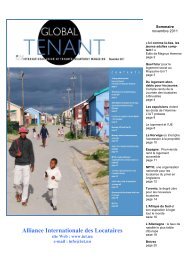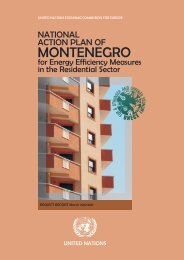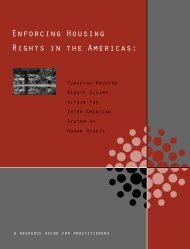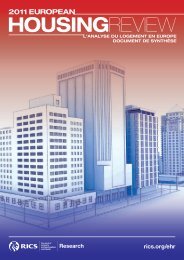housing developments in european countries - Department of ...
housing developments in european countries - Department of ...
housing developments in european countries - Department of ...
Create successful ePaper yourself
Turn your PDF publications into a flip-book with our unique Google optimized e-Paper software.
Section 2<br />
Context<br />
Context Section 2<br />
The M<strong>in</strong>istry <strong>of</strong> Economic Affairs<br />
and Communications, and the<br />
Estonian Credit and Export<br />
Guarantee Fund (KredEx), will<br />
carry out this development plan, <strong>in</strong><br />
co-operation with local authorities<br />
and non-governmental<br />
organisations <strong>in</strong> the <strong>hous<strong>in</strong>g</strong> sector.<br />
The plan will be revised at least<br />
once every four years (by 2006 at<br />
the latest).<br />
The implementation <strong>of</strong> the plan<br />
Dwell<strong>in</strong>gs by type (2002) Apartments <strong>in</strong> 5-16 storey build<strong>in</strong>gs 35<br />
will be governed by an annually<br />
Apartments <strong>in</strong> 1-4 storey build<strong>in</strong>gs 30<br />
S<strong>in</strong>gle family houses 35<br />
drafted action plan that details the<br />
nature <strong>of</strong> the arrangements for the<br />
implementation <strong>of</strong> each <strong>of</strong> the<br />
Dwell<strong>in</strong>gs by the availability <strong>of</strong> facilities (2000) Runn<strong>in</strong>g water<br />
Lavatory<br />
Bath or shower<br />
82<br />
72<br />
68<br />
various measures. The<br />
Central heat<strong>in</strong>g 59<br />
development plan will be f<strong>in</strong>anced<br />
by central government, <strong>in</strong>clud<strong>in</strong>g the government’s<br />
extra budgetary ownership reform reserve fund, and<br />
from the resources <strong>of</strong> the KredEx foundation.<br />
Supervision <strong>of</strong> the implementation is based on a<br />
regular evaluation <strong>of</strong> the measures and sub-activities<br />
conta<strong>in</strong>ed <strong>in</strong> the action plan.<br />
The Estonian <strong>hous<strong>in</strong>g</strong> stock is comparatively young<br />
compared to the rest <strong>of</strong> Europe. Just 18.9% <strong>of</strong> the<br />
<strong>hous<strong>in</strong>g</strong> stock was constructed prior to 1945.<br />
However, the standard <strong>of</strong> dwell<strong>in</strong>gs <strong>in</strong> this country is<br />
lower than <strong>in</strong> the majority <strong>of</strong> other <strong>countries</strong> exam<strong>in</strong>ed<br />
<strong>in</strong> this review. In 2002, the floor area <strong>of</strong> dwell<strong>in</strong>gs <strong>in</strong><br />
this country was 26.5 m 2 per occupant. Furthermore,<br />
<strong>in</strong> the same year only 82% <strong>of</strong> dwell<strong>in</strong>gs had runn<strong>in</strong>g<br />
water, 72% had a lavatory and only 59% had central<br />
In 2002, the <strong>hous<strong>in</strong>g</strong> stock <strong>in</strong> Estonia stood at 618,561<br />
heat<strong>in</strong>g.<br />
dwell<strong>in</strong>gs which constitutes 454.8 dwell<strong>in</strong>gs per 1,000<br />
<strong>in</strong>habitants. TABLE 2.8.1 reveals that <strong>in</strong> 2002 the vast<br />
Over 6,000 households (1.2%) live <strong>in</strong> a dwell<strong>in</strong>g that<br />
majority (85%) <strong>of</strong> these dwell<strong>in</strong>gs were owneroccupied;<br />
does not meet the m<strong>in</strong>imum requirements. Their<br />
<strong>in</strong>deed the level <strong>of</strong> owner occupation <strong>in</strong><br />
dwell<strong>in</strong>g lacks either electricity, heat<strong>in</strong>g, access to<br />
Estonia is amongst the highest <strong>of</strong> the <strong>countries</strong><br />
water or toilet facilities. Nearly 150,000 households<br />
exam<strong>in</strong>ed <strong>in</strong> this report. In 2002, 9% <strong>of</strong> dwell<strong>in</strong>gs <strong>in</strong><br />
(25.8%) live <strong>in</strong> dwell<strong>in</strong>gs where they feel a lack <strong>of</strong><br />
this country were rented from private landlords while<br />
privacy (shar<strong>in</strong>g the dwell<strong>in</strong>g or some facilities with<br />
just 3% were public rented. Under the terms <strong>of</strong> the<br />
other households).<br />
Dwell<strong>in</strong>gs Act there is a ceil<strong>in</strong>g on the rents which can<br />
be charged for these dwell<strong>in</strong>gs, so they can be classified<br />
In 2000 the vacancy rate <strong>in</strong> Estonia was 6.2% <strong>of</strong> total<br />
as social rented.<br />
<strong>hous<strong>in</strong>g</strong> stock.<br />
2.8.2 Stock<br />
Table<br />
2.8.1<br />
Characteristics <strong>of</strong> the Hous<strong>in</strong>g Stock <strong>in</strong> Estonia, 2000, 2002<br />
Category %<br />
Dwell<strong>in</strong>gs by period <strong>of</strong> constriction (2002) < 1945 18.9<br />
1946-1960 8.3<br />
1961-1970 14.5<br />
1971-1980 15.8<br />
1981-1990 15.7<br />
1991 and later 4.1<br />
Unknown 22.8<br />
Households by tenure <strong>of</strong> dwell<strong>in</strong>g (2002) Owner-occupied 85<br />
Private rented 9<br />
Social rented 3<br />
Table<br />
2.8.2<br />
Category<br />
Economic Trends <strong>in</strong> Estonia, 1996-2003<br />
significantly between 1996 and 2003, average<br />
economic growth for this period was above the average<br />
for the <strong>countries</strong> exam<strong>in</strong>ed <strong>in</strong> this review. At the same<br />
time, <strong>in</strong>flation <strong>in</strong> Estonia has fallen from very high<br />
rates <strong>in</strong> the mid-1990s, but the rate <strong>of</strong> unemployment<br />
has <strong>in</strong>creased recently from 9.6% <strong>in</strong> 1997 to 11.8% <strong>in</strong><br />
2001.<br />
2.8.4 Demography<br />
The population <strong>of</strong> Estonia stood at 1.36 million people<br />
<strong>in</strong> 2002, which is 10% below the equivalent figure for<br />
1992 <strong>of</strong> 1.54 million and equal to the 1970 population<br />
level.<br />
Year<br />
1996 1997 1998 1999 2000 2001 2002 2003<br />
% % % % % % % %<br />
Real <strong>in</strong>crease <strong>in</strong> GDP <strong>in</strong> constant (1995) prices 3.9 9.8 4.6 -0.6 7.3 6.5 6.0 4.7<br />
Annual average change <strong>in</strong> the harmonised <strong>in</strong>dex<br />
<strong>of</strong> consumer prices 19.8 9.3 8.8 3.1 3.9 5.6 Nav Nav<br />
Unemployed persons as a% <strong>of</strong> the labour force Nav 9.6 9.2 11.3 12.5 11.8 Nav Nav<br />
Table<br />
2.8.3<br />
Demographic Trends <strong>in</strong> Estonia, 1992-2000<br />
Although this population decl<strong>in</strong>e has affected all parts<br />
<strong>of</strong> the country, the rate <strong>of</strong> decl<strong>in</strong>e has been much more<br />
rapid <strong>in</strong> rural areas. In the north-eastern part <strong>of</strong><br />
Estonia, for <strong>in</strong>stance, the population has decreased<br />
over 20% dur<strong>in</strong>g the last decade. TABLE 2.8.3 reveals<br />
that the reason for this decl<strong>in</strong>e is the low number <strong>of</strong><br />
births, which have consistently been exceeded by<br />
deaths s<strong>in</strong>ce 1992. This has <strong>in</strong> turn led to a fall <strong>in</strong> the<br />
proportion <strong>of</strong> the population aged under 18 years. In<br />
addition, high negative rates <strong>of</strong> net migration,<br />
particularly dur<strong>in</strong>g the early 1990s, also affected<br />
population decl<strong>in</strong>e, although this trend has reversed<br />
s<strong>in</strong>ce 2000.<br />
Category 1992 1994 1996 1998 2000<br />
Population by age group (%) 0-14 years 22.0 21.1 20.3 19.2 18.3<br />
15-24 years 13.9 14.2 14.2 14.3 14.4<br />
25-49 years 34.2 34.3 35.2 35.5 34.7<br />
50-64 years 17.9 17.6 16.9 16.8 17.7<br />
65-79 years 9.3 10.0 10.7 11.5 12.3<br />
> 80 years 2.6 2.7 2.7 2.6 2.6<br />
Population change<br />
(per 1,000 population) Net migration -27.1 -14.3 -9.5 -4.7 0.2<br />
National population change -1.4 -5.5 -4.1 -5.3 -3.9<br />
Average number <strong>of</strong> persons per private household Nav Nav Nav 2.6 2.6<br />
In its design, the Estonian <strong>hous<strong>in</strong>g</strong> stock is dist<strong>in</strong>ctive<br />
<strong>in</strong> European terms. TABLE 8.2.2 reveals that <strong>in</strong> 2002,<br />
35% <strong>of</strong> all dwell<strong>in</strong>gs <strong>in</strong> the country were <strong>in</strong> high-rise<br />
apartment blocks while a further 30% were <strong>in</strong> low-rise<br />
apartments.<br />
2.8.3 Economy<br />
TABLE 2.8.2 sets out details <strong>of</strong> key economic trends <strong>in</strong><br />
Estonia <strong>in</strong> recent years. It reveals that although the rate<br />
<strong>of</strong> <strong>in</strong>crease <strong>in</strong> GDP <strong>in</strong> the country fluctuated<br />
34 European Union Report<br />
Regular National Report on Hous<strong>in</strong>g Developments <strong>in</strong> European Countries<br />
35





